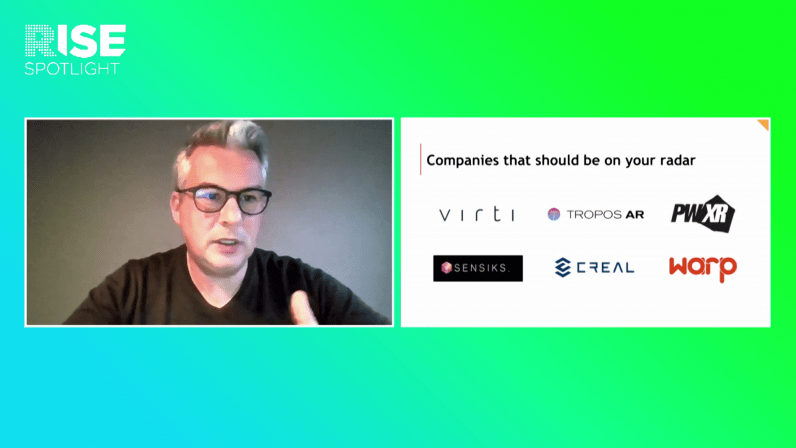Emerging tech like AI, robotics, IoT, blockchain, and machine learning are kicking our organizations into high gear by catapulting our ability to process data, build products, and automate repetitive tasks.
Andy Lurling, Founding Partner of impact-driven VC firm, LUMO Labs believes this shift will pave the way for us to find new and better solutions to some of society’s biggest problems.
“If you want to create social impact fast, technology is the way. For example, with AI and data, you can find patterns so much faster and come up with a thousand alternatives that would take people years to work on.”
But in our ‘data-driven’ era, there is one fledgling technology that could (ironically) help us humanize the future of tech.
XR technology is based on enhancing the human experience by bringing our senses into the mix. This helps, not only to make the experience more realistic, but also makes it more personalized and emotional.
“Take for instance, a digital twin of a city, where you can immediately see all the possibilities instead of simply looking at a spreadsheet. You could ask yourself ‘what would be the effect of having 10,000 fewer ambulances in the city?’ If you instead simulate the experience of being there, it would trigger another part of your brain where emotion is also involved.”
“In a spreadsheet, that’s just a number but if you’re in a VR, where you can see the actual effect, you might have another outcome,” he said.
Speaking with Lurling at ISE’s Rise Spotlight event on XR in Today’s Reality, he shared five examples across industries of startups that are harnessing the power of XR to solve some of society’s biggest challenges.

Learning 4.0
Education, whether in the classroom or in the workplace has been in need of disruption for a long time coming now.
“We’re still in an educational system that was developed for the industrial revolution but we’re now in 4.0 and we’re still mainly taught by reading textbooks. But the world changes so fast now (especially the world of tech) that, after publishing a book, it quickly becomes outdated,” Lurling said.
This year, the experience of having to study and work from home really pushed a lot of companies and schools to begin using this tech for the first time and, after getting a taste of the potential benefits it can bring, it’s unlikely to slow down. A study by PwC found that VR learners are:
- 4x faster to train than in the classroom
- 275% more confident to apply skills learned after training
- 4x more focused than their e-learning peers
The study also found that, because of the more immersive learning experience, VR learners are 3.75x more emotionally connected to content than classroom learners. And this emotional connection can make a huge difference when it comes to really understanding and retaining knowledge.
In the high-pressure, fast-paced environment healthcare workers face every day, staying on top of workplace training is extremely difficult. But this can lead to deadly consequences. According to VR startup, Virti, one of the leading causes of death globally is actually medical error.
The company is using on-demand VR based training, to help improve accessibility, scalability, and knowledge retention of workplace trainings for medical professionals.
Rather than learning in a classroom or from a text, simulating a patient care experience helps increase a learner’s emotional connection to the content and empathy, thereby greatly reducing the risk of medical error and improving patient safety.
[embedded content]
And it’s not just the medical industry that could benefit from XR tech.
With such wide-ranging clients as KLM, the BBC, and Gazprom, Warp VR is helping train engineers in workplace safety, simulate sales trainings, and prepare staff for emergency situations.
Imagine how nerve-wracking it would be to walk into a meeting with a board of directors and pitch your company’s product for the first time? Instead of throwing sales newbies into the deep end, VR training can help provide a more lifelike training experience that prepares them for the real thing.
[embedded content]
Using sensory reality to treat mental health
There are billions of people across the globe living with mental health issues, from depression and anxiety to dementia. And leading experts from the WHO, the Red Cross, and academic institutions like Harvard University have warned that Covid-19 will only exacerbate this problem, potentially leading to a mental health crisis.
But XR technology is providing new opportunities and solutions. While we may not be able to fully understand what patients are going through, by combining sight, sound, smell, and touch, psychologists and researchers have been able to simulate emotional experiences, helping them treat patients with different psychological conditions.
One company making particularly interesting progress in this field is the Netherlands-based Sensiks. They teamed up with a clinical psychologist from the University of Amsterdam to help find new ways to treat phobias and the effects of emotional trauma, with a special focus on patients with PTSD.
With their sensory reality pods that go beyond visuals to include heat, wind, airflow, tremble, light, and sound effects, they’ve been able to recreate the sense of being in wartime or other traumatizing situation.
[embedded content]
This has helped patients to draw out their emotions during therapy sessions, and psychologists to study the effects of different treatments.
This year they announced a new partnership to provide a short-term treatment strategy for traumatized healthcare workers during COVID-19.
As the company’s philosophy states: “What computer programming did for the digitization of society and economy in the last two decades is what Sensory Reality will do for understanding and optimizing the mental state of human beings.”
Taking consumer personalization to the next level
This year, with consumers sheltering in their homes, we saw more and more marketing teams begin to experiment with AR and VR tech. From “try before you buy” to virtual expanded product views that allow customers to see the fine details of a product before they drop it into their online shopping cart.
But Lurling believes this is only the beginning. With looming budget cuts, advertisers will need to focus spending on more targeted bets that will reach higher ROI thresholds. Emerging tech, with a major boost from XR, will be the key to the future of hyper-personalized advertising in our homes and on the streets.
One great example he shared was Tropos AR, an advertisement solution that allows consumers to choose which types of products they’re most interested in. The solution then uses a combination of AR and blockchain to share personalized ads, discounts, and coupons.
[embedded content]
“Tropos AR uses a perfect convergence of technology. What they do really well is that they make a connection with the customer. When you go to a shopping street, you get all the advertisements. But Tropos makes it so that you only see the advertisements that you’re interested in.”
Studies show that 43% of consumers are willing to adopt store tech if it alleviates time and ease. In fact, Shopify found that products with AR content have a 94% higher conversion rate.
This means, rather than investing in a billboard that only a small section of your target audience may see on the high street, you can instead reach them directly with personalized ads. In this way, putting consumers in control provides better, more personalized deals for them and much better ROI for companies.
Gamifying our physical health
For most of us, exercise is that annoying chore that no amount of athleisure wear or peppy gym instructors can make even remotely enticing. But what if we could somehow actually make working out fun?
While the world of tech has brought us forward in many ways, it also has its drawbacks. The more screen time we spend, the less time we spend on the move.
“In 2019, the WHO published a report showing that 80% of young people are developing conditions you normally see in elderly people. And, to a large extent, that group includes gamers,” Lurling said.
In fact, the health organization recently added ‘gaming disorder’ to its list of diseases. But he also believes that XR can provide some solutions that are way more fun than simply hitting the track more often.
“If you bring a physical element to gaming, you can create an environment which is like Ready Player One,” Lurling said.
XR is helping us expand our gameplay by combining visuals with interactive touch-based games that follow your body’s movement. And studies show that virtual-reality ‘exergaming’ can actually increase enjoyment and performance.
Eindhoven based Active Sports Arena is one example. Their wire and controller-free VR games are being used by companies to make team building activities and even brainstorming sessions more interactive.
[embedded content]
Improving the XR experience
While XR is helping us in so many ways, in some cases, after prolonged periods of time, VR and AR tech can cause eye strain, headaches, fatigue, and nausea.
Because the flat plane 3D images we see in XR headsets don’t actually contain real depth, our eyes aren’t able to naturally focus in and out of them as they would with real-life images. But advances in what’s called light-field technology are helping to make XR images more life-like and, of course, easier on the eyes.
In a market dominated by tech giants, like Facebook’s Oculus, Swiss startup CREAL is bringing some serious competition. Their light-field technology improves depth resolution of virtual objects, allowing them to blend in more easily with the real world. This doesn’t just provide a more immersive virtual experience, it also eliminates the harsh side effects and eye strain.
[embedded content]
As we can see, XR is on the rise and it’s only expected to pick up steam moving forward. While the market for AR and VR solutions was less than $12 million in 2019, ABI Research has forecasted the market to exceed $400 million by 2025.
“I believe in the convergence of technology and that, in the future, our solutions will combine things like AI, machine learning, and blockchain, with XR being how it’s displayed,” Lurling said.
But, while this tech really stepped in during this year to help alleviate the transition to at-home work, learning, patient care, and more, he believes it won’t replace our need for in-person social interaction.
“For learning, shopping, and experiencing, it will grow further. But, my belief is that the social element will shrink after social distancing ends because you can’t replace human connection.”
Hungry for more of the latest tech tools and innovation? Sign up now for the next edition of RISE Spotlight: Harness the Power of Digital Learning on January 15 at 15:00 CET.
Below you can find the official video showing some of the highlights of the first RISE Spotlight event on Workspace Evolution.
[embedded content]

This post is brought to you by ISE.
Published January 8, 2021 — 10:58 UTC
